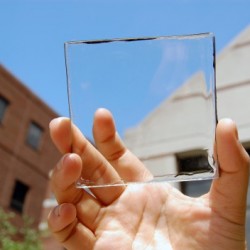 Solar power with a view: MSU doctoral student Yimu Zhao holds up a transparent luminescent solar concentrator module. Image © Yimu Zhao
Solar power with a view: MSU doctoral student Yimu Zhao holds up a transparent luminescent solar concentrator module. Image © Yimu Zhao
Solar harvesting systems don’t need to be glaringly obvious. In fact, now they can even be invisible, thanks to researchers at Michigan State University (MSU) who have developed a transparent luminescent solar concentrator (LSC) that can be applied to windows or anything else with a clear surface.
LSC technology is nothing new, but the transparent aspect is. Previous attempts yielded inefficient results with brightly colored materials, and as researcher Richard Lunt, an assistant professor of chemical engineering and materials science at MSU, puts it, “No one wants to sit behind colored glass.” To learn how Lunt and the rest of the research team achieved transparency, keep reading after the break.
 A transparent luminescent solar concentrator waveguide is shown with colorful traditional luminescent solar concentrators in the background. Image © G.L. Kohuth
A transparent luminescent solar concentrator waveguide is shown with colorful traditional luminescent solar concentrators in the background. Image © G.L. Kohuth
The new LSC technology is made transparent by targeting wavelengths of sunlight that are not in the visible spectrum. The LSC technology uses small organic molecules to pick up ultraviolet and near infrared wavelengths that then ‘glow’ at another wavelength in the infrared. This infrared ‘glow’ is directed towards the edge of the plastic where it is converted by thin strips of photovoltaic cells into electricity.
The transparent LSC technology currently only achieves a solar conversion efficiency close to 1 percent, while the best colored LSC technology is able to achieve an efficiency of approximately 7 percent. In the future, the research team expects to optimize their technology’s energy-producing efficiency somewhere beyond 5 percent (compare this to around 15-20 percent for a commercially available photovoltaic cell).
 Yimu Zhao, a doctoral student in chemical engineering and materials science, and Richard Lunt, assistant professor of chemical engineering and materials science, run a test in Lunt’s lab. Image © G.L. Kohuth
Yimu Zhao, a doctoral student in chemical engineering and materials science, and Richard Lunt, assistant professor of chemical engineering and materials science, run a test in Lunt’s lab. Image © G.L. Kohuth
Transparent LSC technology has many benefits in addition to being aesthetically pleasing. Firstly, it could be used in a variety of applications and has the potential to be scaled to both commercial and industrial applications at an affordable cost, from windows to cell phone screens. Secondly, the technology can be used to manage solar heat gain since it specifically targets infrared wavelengths. According to Lunt, “There are already window film technologies that aim to reject infrared light such as low-E coatings. We aim to have a similar functionality while also generating electricity.”
The rest of the MSU research team consists of Yimu Zhao, a doctoral student in chemical engineering and materials science; Benjamin Levine, an assistant professor of chemistry; and Garrett Meek, a doctoral student in chemistry.


